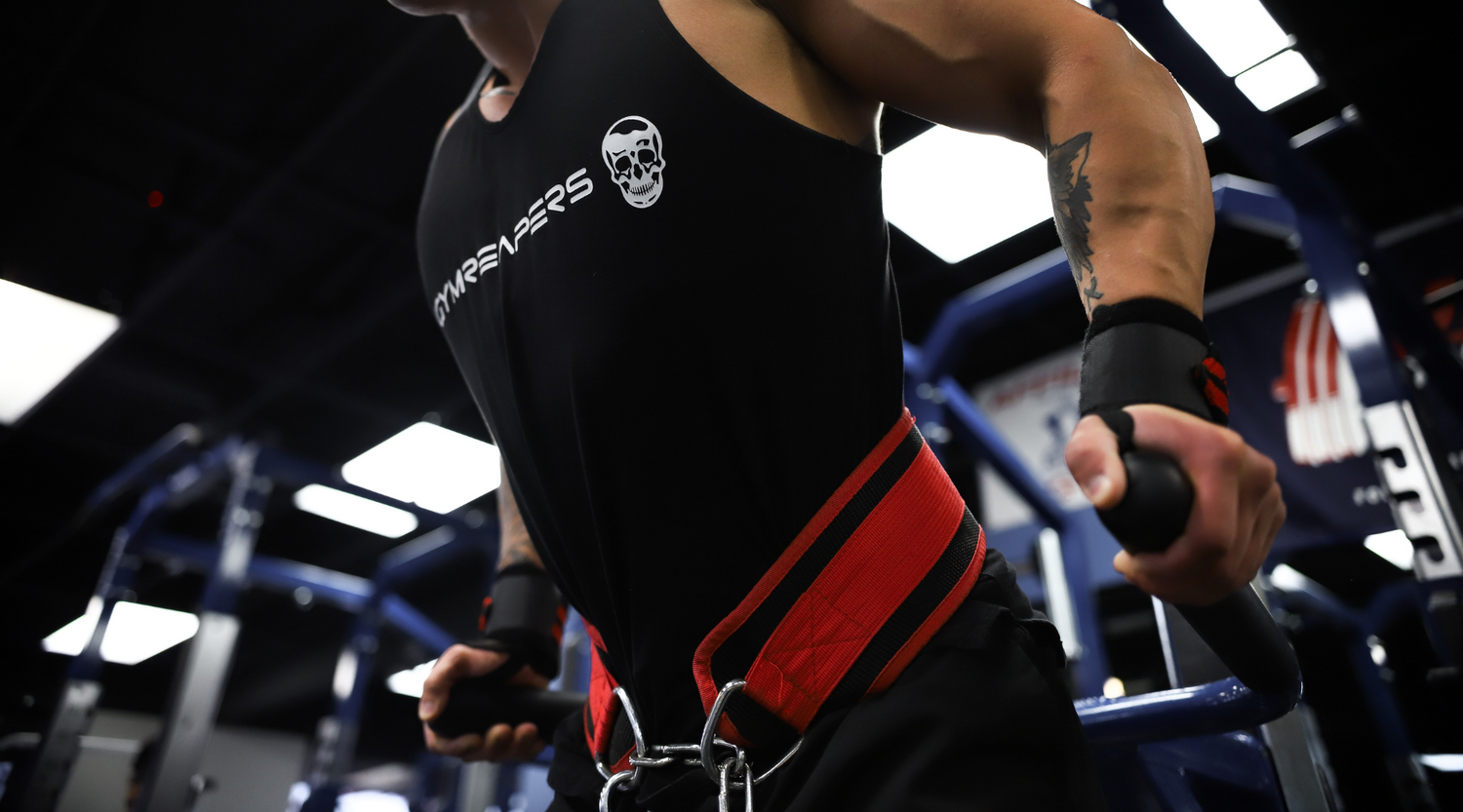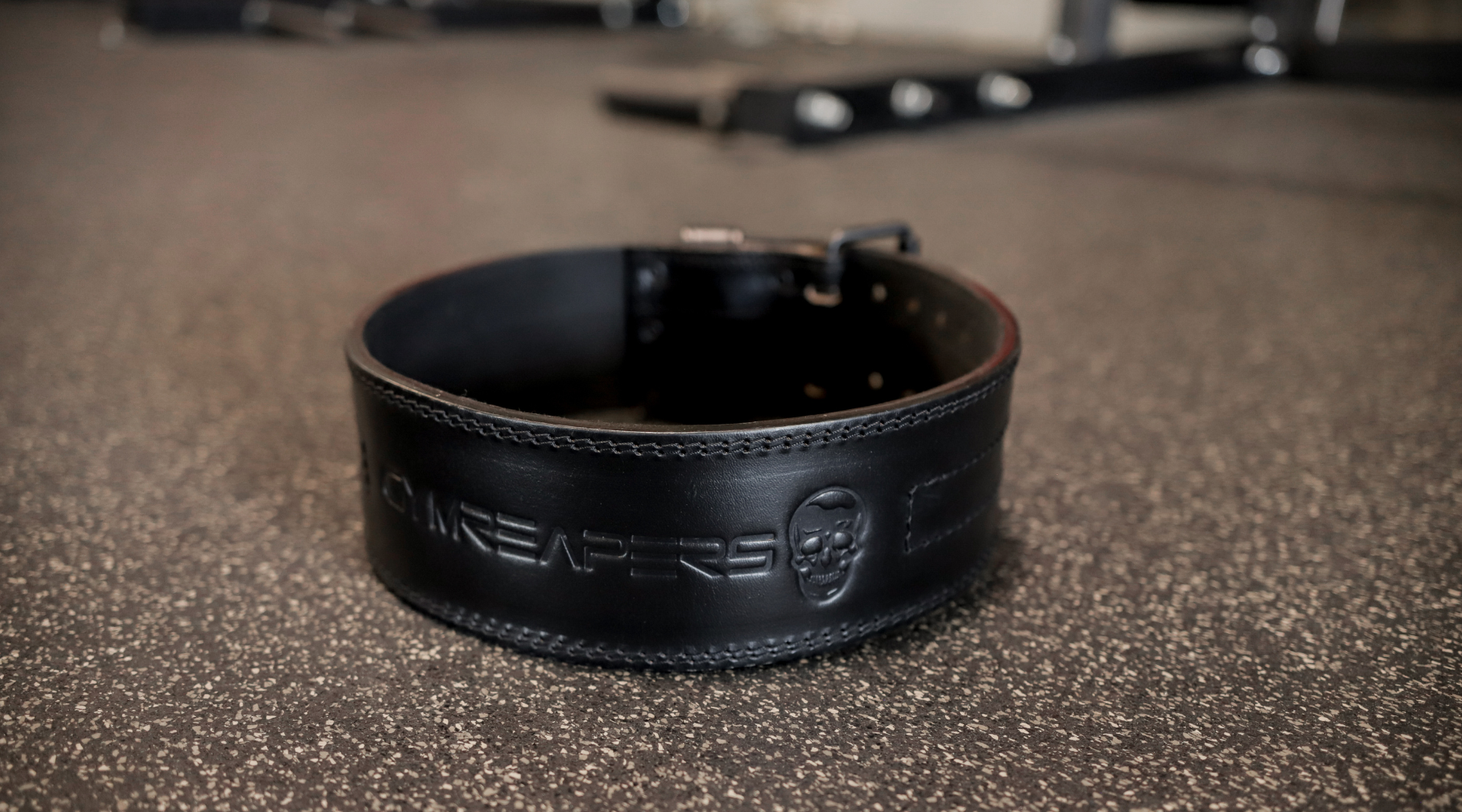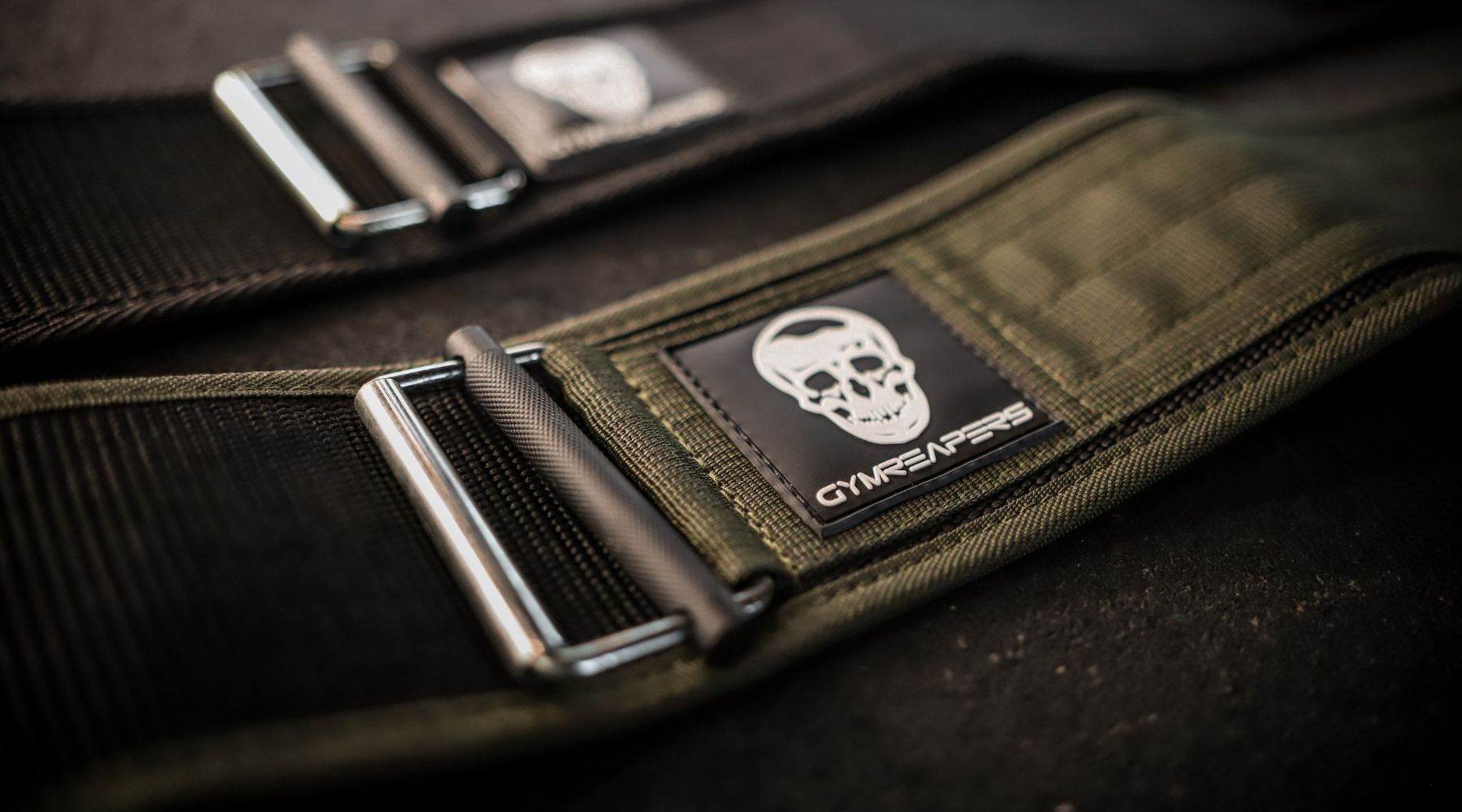A dip belt will take your accessories to the next level. Whether you’re training your dips and pull-ups or your belt squats and calf raises, this is the tool to have.
Before you start using a dip belt, you should learn what type of belt to look for, how to use it, what to use it for, and how to troubleshoot any issues.

Below, we walk you through the entire process of using a dip belt.
Key Takeaways
- Dip belts are tools to overload your bodyweight accessories and can be used for dips, pull-ups, chin-ups, calf raises, and belt squats.
- You can use either a plate, dumbbell, or kettlebell to load your dip belt.
- Dip belts have a chain that wraps around the load of your choosing, and then cinched tightly with a carabiner in order to secure it in place.

What Is A Dip Belt?
A dip belt looks similar to a typical lifting belt, with one major difference: the front of a dip belt has a chain, chain loops, and a carabiner to allow for weights to be securely strung from the waist.
Two Types of Dip Belts: Fabric & Leather
1. Fabric Dip Belts
Fabric dip belts are more flexible than leather belts, allowing for a snug, conformed fit to a lifter. They are usually made from a combination of cotton, nylon, and neoprene.
This type of dip belt is ideal for lifers who are new to using dip belts or aren’t going to be lifting over 95 lbs with it.
Even if you are going to be lifting heavier weights with it, you can still consider a fabric dip belt because you aren’t usually wearing a dip belt on an everyday basis (like a normal training belt).
As such, the wear and tear on the belt material will be limited.
2. Leather Dip Belts
Leather dip belts aren’t as popular, and they’re harder to find.
However, they do exist and their differentiating factor is that leather is more durable than nylon.
They won’t be as comfortable to wear as a nylon lifting belt, but because leather is a stronger material, they shouldn’t have as much wear and tear under heavier loads or with frequent use.
In my opinion, though, leather dip belts aren’t worth the extra cost. Simply look for a high-quality, well-made nylon dip belt (not a cheap one off Amazon). For example, the Gymreapers dip belt is rated up to 300lbs.
Benefits of Using A Dip Belt

Can be used to overload many bodyweight movements
Dips, pull-ups, and chin-ups tend to be the foundation of a lifter’s upper body accessories.
As a lifter gets stronger, dip belts offer ways to load each of those movements in a way that is convenient and secure.
Custom weight selection, efficiently
The dip belt allows for a variety of weights to be loaded quickly.
For those who are just starting to use a dip belt, they can load up 1, 2, 5, 10lbs and more as they progress.
For more advanced lifters, they are able to load 45, 60, and even 95+lbs.
Because dip belts are so easy to load, training partners can load different weights quickly between sets.
Load weight in a secure manner

Because of the durability of the main chain, lifters can use kilo plates, kettlebells, and even bands, to add resistance.
The chains are highly durable, reducing the risk of weight plates falling on ankles and shins.
For example, one of the primary ways to add load without the use of a dip belt is to place dumbbells between your legs. This has the potential to hit your foot or ankle if dropped mid-set. This is avoided by using a dip belt.
One Size Fits All
If you are working out with training partners of different sizes, you can swap the belt for all sizes and heights.
That means more time training, and less time messing with your equipment.
How To Properly Use A Dip Belt
Strap the belt around your waist
The chain and loops should be positioned in front of you. If there is a tapered or padded area, be sure to position that area in the middle of your back.
Feed the chain from loop to loop
The chain will come through the original loop to the loop across your waist. Pull the chain to your desired tightness.
Pick Your Weight
Take the desired weight and loop the chain through any opening in the plate or weighted object. You can loop it through the center hole if you have bumper or kilo plates. Any other plate with holes on the sides can be arranged in either placement.
Pull all slack out of the chain
This will let you control the desired height of the chain. The weight should not be dragging on the floor or constricting your movement.
Securely clasp the carabiner into position
Once the designated height has been reached, pull the carabiner back to the original loop and secure it. Make sure it snaps or locks before starting.
Begin the Exercise
Get into your typical position for the movement that you are doing and begin. The weight should not be aggressively hitting you or the floor.
Mistakes To Avoid When Using A Belt For Dips

Your dips don’t look the same
When you are first using a dip belt and you add load, what you will often notice is that your movement mechanics change.
With the weight dangling it may cause you to reduce your overall range of motion or cause you to have to use more of your stabilizing muscles as you balance the new weight.
If you notice these changes, I would advise loading less weight for several weeks to learn how to complete the movement efficiently with the new load, before adding additional plates.
Your chain is too long
If the chain is set to be too long, weights will drag on the floor. If the weight touches the floor, the weight unloads on the floor reducing the load that you are lifting.
Also, dropping the weight on the floor is jarring, and will force you to compensate and rebalance.
The weight chain is not clipped
If you don’t securely clip the chain back to the belt, all of the weight you loaded will fall to the floor and may hit your shins and ankles.
You’re wearing the belt too high or too low.
The belt will naturally sink as it is loaded. If you cinched the belt high up on your torso, it is likely that the belt will slip down throughout the movement, causing the weights to swing and force you to rebalance.
If you are wearing the belt below your hips, it will drag further down as it is loaded, and you are likely to drop the belt and the plates to the floor, unable to complete your weighted dips.
Can You Wear A Regular Lifting Belt For Dips?

It is possible to convert a regular lifting belt into a DIY dip belt.
The Chain Method
If you have a typical single prong or lever belt and a length of chain with a clasp, you can wind the chain through the front of the belt to create the loop needed to add weights.
Once you cinch the lifting belt to your typical width, the belt will be snug across your frame and will allow for the chain to swing.
The downside of this method is that you have to spend the time to visit your local hardware store to purchase and cut the chain yourself. If you don’t cut enough chain, then it will be hard to customize the belt length for different exercises.
The Band Method
If you do not have a length of chain, you can also use a band looped over your belt and fastened to the floor with either a heavy dumbbell or some other immovable object.
The band will then provide resistance to the concentric portion of the lift.
However, this method should only be used in the case of not having access to a dip belt.
Using a band is not comfortable, requires time to set up, and makes every movement jerky and unstable.
What Exercise Can You Use A Dip Belt For?

Pull-Ups, Chin-Ups, and Calf Raises
The belt set up for pull-ups, chin-ups, and calf raises is the same as it is for dips. You will fasten the belt around your waist and load accordingly.
DIY Belt Squats
There are two different ways you can use a dip belt for “belt squats”. You can either use the dip belt and two raised steps or you can use a dip belt and a barbell in a “landmine” position.
Belt Squats with a Dip Belt and Barbell
Frequently Asked Questions
How Do Dip Belts Stay On?
The chain, once pulled through the opposite side of the belt, will pull snuggly across the hips.
What Is The Max Weight For A Dip Belt?
Most chains can sustain 250+ pounds so lifters and the weights that they can arrange are typically the main limiting factor. Even advanced lifters don’t typically need more than 150 lbs.
How Long Should The Chain Be On A Dip Belt?
The chain should be long enough that the weight can swing and be out your way, but not so long that the weight drags on the floor. Once the weight drags on the floor, it can throw off your movement and also deload part of the weight.
Are Dip Belts One Size Fits All?
Yes, dip belts can be arranged for all weight and height ranges. This means that you and your training partners can all train with the same piece of equipment.













Leave a comment
All comments are moderated before being published.
This site is protected by hCaptcha and the hCaptcha Privacy Policy and Terms of Service apply.